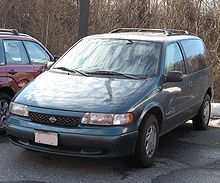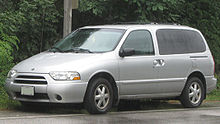- Nissan Quest
-
Nissan Quest 
Manufacturer Nissan (2004–present)
Ford Motor Company (1993–2002)Production Japan:
1993–1998
North America:
1993–2002
2004-2009
2011-presentPredecessor Nissan Axxess
Nissan VanetteClass Minivan Layout FF layout The Nissan Quest is a minivan manufactured since 1993 by Nissan, and is now in its fourth generation. The first two generations of the Quest were a joint venture with Ford, which marketed a rebadged variant as the Mercury Villager. The vans debuted at the 1992 North American International Auto Show in Detroit.
Both vehicles were initially powered by the 3.0 L Nissan VG30E V6 until 1999, when the Quest received the 3.3 L version of the same engine and a few minor updates, including a driver side sliding door, and grill and rear redesigns. The Quest was later completely redesigned for 2004, while the Villager was discontinued and replaced with the Freestar-based Mercury Monterey. The third generation model was built on the FF-L platform, which it shares with the Altima, Maxima, and Murano. It also shares the award-winning 3.5 L VQ engine with those cars. The fourth generation model is built on the same platform as the 2011 Nissan Elgrand.
Contents
History
First generation (1993–1998)
First generation 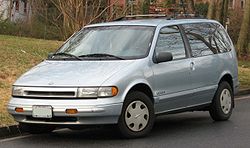
Also called Mercury Villager Production 1993–1998 Assembly Ford's Ohio Assembly, Avon Lake, Ohio Body style 3-door minivan Platform Ford VX54 platform (1993–2002) Engine 3.0 L VG30E V6 Transmission 4-speed automatic Wheelbase 112.2 in (2,850 mm) Length 189.9 in (4,823 mm) Width 73.7 in (1,872 mm) Height 67.5 in (1,715 mm) (Cargo)
65.6 in (1,666 mm) (1993-95 XE)
68 in (1,727 mm) (GXE & 1996-98 XE)The Nissan Quest was a new model made by Nissan to compete in the minivan segment. The Quest was a successor to the Axxess, which was sold in the United States in 1990 only and in Canada from 1990-1995. It also replaced the rear-wheel drive Vanette, also discontinued in 1990. The Quest was initially powered by Nissan's 3.0 L VG30E SOHC engine that made 151 hp (113 kW) and 182 lb·ft (247 N·m). Ford required that Nissan make some design changes to the VG30E before they would agree to use it in the Villager and Quest. One of the requirements from Ford was that the engine was to be modified to become a non-interference or free-running engine. (Thus if the timing belt breaks, there would be no damage to the valves). Other changes included the addition of an oil level sensor and relocating the oil filter assembly for better access. The Quest was available as XE or GXE models. Because of manufacturing issues, Nissan had an arrangement for Ford to assemble the minivan in North America, and in turn they were allowed to rebadge it and sell it under the Mercury brand as the Villager. Many of the interior parts, including the radio, heater controls and power windows controls were adapted from Ford, and were similar to the Ford Aerostar. This generation of the Quest and Villager was built at Ford's Ohio Assembly plant in Avon Lake, Ohio. The van shared the modified version of the VG30E from the U11, and early J30 Maximas, as well as the 4-speed automatic transmission from the Maxima. The Quest/Villager engine seems to have a serious flaw in the crankshaft, as they break at the front stub. Nissan increased the diameter from 25 to 27 mm around 1995. The Quest is distinguishable from the Mercury Villager by a different grille, side trim, front and rear bumpers, and tail lights.
Seating was for 7, with a removable 2-seater bench in the middle, allowing the third row bench of 3 seats to slide up (either folded up for more room or down for passengers) behind the front for more rear cargo room. 1994 the first year for the driver's side airbag, with a passenger airbag added in 1996. That year saw the introduction of changes to the front and rear fascias, as well as headlights and tail lamps and the elimination of the motorized shoulder belts.
The headlamp assembly for 1996-1998 Quests will fit into 1993-1995 Quests. The only modification required is to the switch the low-beam (center pin) and ground pins on the light bulb socket. The newer assembly will also use the brighter 9007 bulb with ~1000 lumens vs ~700 of the 9004 bulb.
Second generation (1999–2002)
Second generation 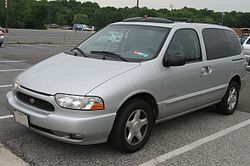
Also called Mercury Villager Production 1999–2002 Assembly Avon Lake, Ohio, United States Body style 4-door minivan Platform Ford VX54 platform (1993–2002) Engine 3.3 L VG33E V6 Transmission 4-speed automatic Wheelbase 112.2 in (2,850 mm) Length 194.6 in (4,943 mm) (2001-02)
194.8 in (4,948 mm) (1999-2000)Width 74.9 in (1,902 mm) Height 64.2 in (1,631 mm)
67.3 in (1,709 mm)For 1999, the Quest was redesigned, and it gave the exterior a more aerodynamic look, and the driver's side sliding door. The Quest also got a power boost via the 3.3 L VG33E SOHC engine, making 171 hp (128 kW) and 200 lb·ft (270 N·m) of torque. The XE trim was discontinued and the GXE was moved as the base model. Two new trim levels were also introduced: the top of the line GLE and the sport model SE. This Nissan Quest model became the first Nissan minivan with 4 doors since the 1995 Nissan Axxess.
The 2001 Quest received various minor improvements. Styling front and rear was updated, along with new alloy wheels on all models. The entry-level GXE gained a rear stabilizer bar, while the SE received acceleration-sensitive strut valving and a strut tower brace. New interior gauges and fabrics as well as a 130-watt sound system were standard on SE and GLE. Luxury GLE models also received an in-dash six-CD changer and a wood and leather-trimmed steering wheel. An optional overhead family entertainment system replaced the former floor-mounted model, though it could still be specified for SEs and GLEs equipped with a sunroof. Front seatbelts were given pretensioners. The 2001 Quest was also slightly longer, with more cargo space than the previous generation. The 2002 Nissan Quest was not sold in Canada. The Quest would not return to Canada until the third generation model arrived in 2004.
By the end of this generation, both Honda and Toyota marketed solely long-wheelbase minivans. No Quest models were marketed for the 2003 model year.
Third generation (2004–2009)
Third generation 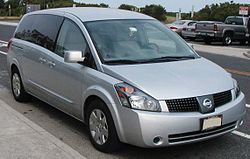
Production 2004–2009 Assembly Canton, Mississippi, United States Body style 4-door minivan Platform Nissan FF-L platform Engine 3.5 L VQ35DE V6 Transmission 4-speed automatic
5-speed automaticWheelbase 124.0 in (3,150 mm) Length 204.1 in (5,184 mm) Width 77.6 in (1,971 mm) Height 70.0 in (1,778 mm) (2004-06)
71.9 in (1,826 mm) (2007-2009)Related Nissan Altima
Nissan Maxima
Nissan Murano
Nissan TeanaAfter the 2002 discontinuation of the Mercury Villager, the third generation Quest was redesigned for the 2004 model year using the previous-generation Nissan Altima and Nissan Maxima platform,Nissan's FF-L platform, in a package slightly longer than the Chrysler long-wheelbase minivans. Production moved to a new plant in Canton, Mississippi.
The Quest is powered by the oft-used 3.5 L VQ35DE engine from the Maxima, Altima, and others. In the Quest, it produces 240 hp (179 kW) and 242 lb·ft (328 N·m) of torque. The Quest has a flat folding rear bench and the two middle chairs fold nearly flat into the floor. The interior volume is 211.9 cubic feet (6.00 m3).
The third generation Quest features an unusual moonroof glass arrangement, and positions for 2 DVD screens with aux input. Also featured in the SE model were side front airbags, curtain airbags for all rows, VSC (Vehicle Stability Control), Traction Control, dual power doors and power rear hatch, Bose audio with RDS and folding second row seats, dual climate control, and rear backup sensors. Nissan redesigned the front grill and the dashboard for the 2007 model. They also moved the DVD player from under the front passenger seat to the IP stack.
The Quest did not return for the 2010 model year, with Nissan stating that the automaker needed room at the Canton plant for production of a commercial vehicle based on the Nissan NV2000 concept.[1]
The Quest suffered from various quality issues in the 2004 model year. Most were addressed near the end of that model by an engineering team sent from Japan to help with the new plant in Canton. Vehicles already sold here fixed by dealers with many Technical Service Bulletins. Also produced in this plant were the Nissan Titan and Infiniti QX56, which also had various quality issues in the first year.
National Sales figures
2003 - 23,170 (From remaining 2002 & 2004 model early sales)
2004 - 46,430
2005 - 40,357
2006 - 31,905
2007 - 28,590
2008 - 18,743
2009 - 8,564
Fourth generation (2011)
Fourth Generation 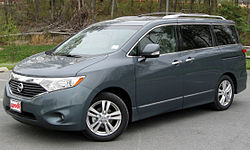
Production 2011- Assembly Shatai, Kyūshū, Japan Body style 4-door minivan Layout FF layout Platform Nissan D platform Engine VQ35DE 3.5L V6 Transmission Continuously Variable Transmission Wheelbase 118.1 in (3,000 mm) Length 200.8 in (5,100 mm) Width 77.6 in (1,971 mm) Height 71.5 in (1,816 mm) Related Nissan Altima
Nissan Maxima
Nissan Murano
Nissan Teana
Nissan ElgrandThe fourth generation Quest is built at the Shatai Kyūshū plant in Japan for 2010. The platform is shared with the current generation Nissan Elgrand.[2] It is powered by Nissan's 3.5L VQ series engine with 260 hp (194 kW). Front wheel drive is standard, and the USDM version has an extra full 5 inches (13 cm) of width to avoid the tall skinny look of Japanese vans. The Quest went on sale in North America in early 2011 as a 2011 model.[1][3] Nissan revealed five teaser images of the 2011 Quest revealing the exterior and interior.[4] In Japan the Elgrand competes with the Toyota Alphard and the Honda Elysion. The 2011 Nissan Quest was unveiled at the 2010 Los Angeles International Auto Show.
References
- ^ a b "Nissan Says No Quest for 2010 – Automotive News & Car Rumors at Automobile Magazine". Rumors.automobilemag.com. http://rumors.automobilemag.com/6592915/news/nissan-says-no-quest-for-2010/index.html. Retrieved 2010-05-10.
- ^ "Next Generation Nissan Quest (R42H) be share New Elgrand (J42H) body Component » Codename, Nissan, QuestElgrand, developingBoth, Shahai, Plant". Autoincar. 2009-07-31. http://www.autoincar.com/next-generation-nissan-quest-r42h-be-share-new-elgrand-j42h-body-component/. Retrieved 2010-05-10.
- ^ "Teased: Nissan Quest". Insideline.com. 2010-03-30. http://www.insideline.com/nissan/quest/teased-nissan-quest.html. Retrieved 2010-05-10."The 2011 Nissan Lineup: Charting the Changes". Nissan News. 2010-06-21. http://www.nissannews.com/newsrelease.do?id=1714&mid=1. Retrieved 2010-06-22.
- ^ "LA Live: 2011 Nissan Quest makes world debut, pricing announced". Leftlanenews.com. http://www.leftlanenews.com/nissan-quest.html. Retrieved 2010-11-20.
2009 Sales http://www.prnewswire.com/news-releases/nissan-north-america-announces-december-sales-80720037.html
Canton Plant quality problems http://detnews.com/article/20060107/AUTO01/601070335/Experts-cite-Mississippi-plant-as-problem-with-Nissan-reliability
External links
Nissan Motor Company Vehicles Current370Z • Advan • Altima • Aprio • Armada • Atlas • Bluebird • Bluebird Sylphy • Cabstar • Caravan • Civilian • Clipper • Cube • Dualis • Elgrand • Frontier • Freeson • Fuga • GT-R • Juke • Lafesta • Leaf • Livina Geniss • Maxima • March • Murano • Moco • Navara • Note • NV200 • NV400 • Otti • Paladin • Pathfinder • Patrol • Qashqai • Quest • Rogue • Safari • Sentra • Serena • Skyline • Teana • Tiida • Titan • Urvan • Versa • Wingroad • X-Trail • XterraPastDC-3 • 100NX • 1200 • 310 • 180SX • 200SX • B-210 • 240SX • 240Z • 280ZX • 300C • 300ZX • 350Z • 510 • 810 • Almera • Almera Tino • Altra (EV) • Avenir • Auster • Bassara • Be-1 • Caball • Cablight • Cedric • Cefiro • Cherry • Cima • Crew • Datsun Truck • Echo • Expert • Fairlady • Figaro • Gazelle • Gloria • Hardbody Truck • Hypermini • Homy • Interstar • Junior • Largo • Laurel • Leopard • Liberty • Mistral • Multi • NX • Pao • Pintara • Pino • Platina • Prairie • Presage • Presea • Primera • President • Pulsar • Pulsar GTI-R • R390 GT1 • R'nessa • Rasheen • Roadster-Road Star • S-Cargo • Saurus • Saurus Jr • Silvia • Sileighty • Skyline GT-R • Stanza • Stagea • Sunny • Terrano • Terrano II • Vanette • VioletConcept126X • 216X • 270X • 300 Bambu • 315-a • AA-X • Actic • AD-1 • AD-2 • AL-X • Alpha T • Amenio • AQ-X • AP-X • ARC-X • AXY • AZEAL • Bevel • Boga • C-Note • Chapeau • Chappo • Cocoon • CQ-X • Crossbow • CUE-X • Cypact • Duad • Dunehawk • Effis • ESV • Evalia • EV Guide II • EV Truck • FEV • FEV-II • Foria • Forum • Fusion • Gobi • GR-1 • GR-2 • GT-R • ideo • Intima • Jikoo • Judo • Jura • Kino • KYXX • Land Glider • LEAF • LUC-2 • MID4 • Mixim • mm.e • Moco • Nails • NCS • NEO-X • NRV-II • NX-21 • NV2500 • Pivo • Pivo 2 • Qazana • Redigo • Round Box • Serenity • Sport Concept • Stylish VI • Terranaut • Tone • Townpod • Trailrunner • TRI-X • URGE • UV-X • XIX • XVL • Yanya • ZarootEngines GRX-3 • UD12 • VRT35Marques Nissan • InfinitiSubsidiaries
and divisionsSee also ATTESA • Datsun • HICAS • Prince • Renault-Nissan Alliance • Nissan Shatai • UD Nissan Diesel • VVL • VVEL • dCi
 Category ·
Category ·  Commons
CommonsType 1980s 1990s 2000s 2010s Model year 0 1 2 3 4 5 6 7 8 9 0 1 2 3 4 5 6 7 8 9 0 1 2 3 4 5 6 7 8 9 0 1 2 Compact crossover Rogue Mid-size crossover Murano Murano Mini SUV Juke Compact SUV Xterra Xterra X-Trail Mid-size SUV Pathfinder Pathfinder Pathfinder Full-size SUV Armada Mini MPV Cube Compact MPV Stanza Wagon/Multi Axxess Minivan Vanette Quest Quest Quest Quest Van NV Pickup Datsun Truck Hardbody Truck Frontier Frontier Titan Categories:- Nissan vehicles
- Minivans
- Front wheel drive vehicles
- 1990s automobiles
- 2000s automobiles
- Vehicles introduced in 1993
- Motor vehicles manufactured in the United States
Wikimedia Foundation. 2010.

